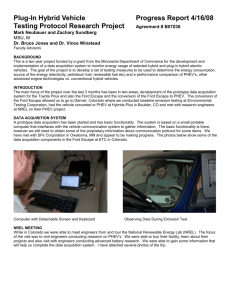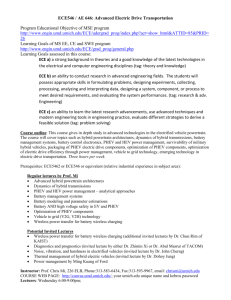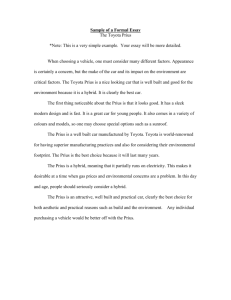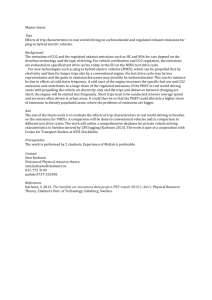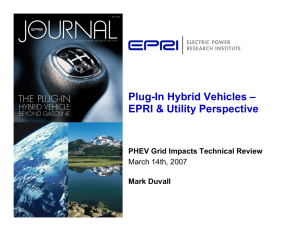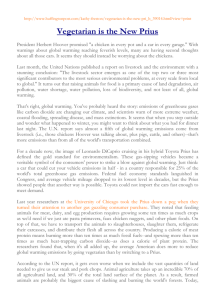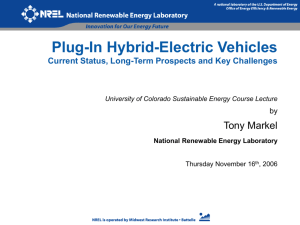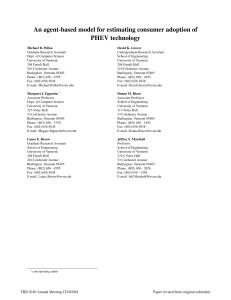Prius - Automotive News
advertisement
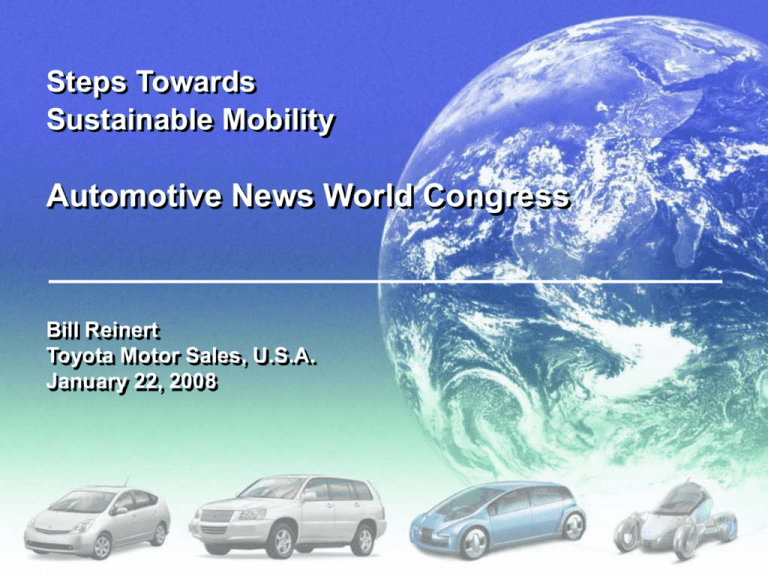
Steps Towards Sustainable Mobility Automotive News World Congress Bill Reinert Toyota Motor Sales, U.S.A. January 22, 2008 The “Big 4” – Issues facing the auto industry Global development of industry & technology in the 21st century Accelerated consumption of fossil fuels 1. Energy & Fuel Diversification 2. CO2 reduction Population growth (esp. BRIC) Growing number of motor vehicles 3. Air Quality 4. Urban Congestion 120 120 Third crisis, world peaks and OPEC plateaus Second crisis, Non-OPEC peaks million b/d 80 60 100 0.75% pa demand 80 First crisis, Non OPEC less FSU peaks OPEC 60 FSU 40 40 Other liquids, biofuels, etc. 20 20 Spare capacity Non-OPEC less FSU 0 0 1950 1955 1960 1965 1970 1975 1980 1985 1990 1995 2000 2005 2010 2015 2020 2025 2030 Used with permission by Dr. Peter Wells million b/d 100 EIA 2007 forecast (1.5% pa) 60,000 60,000 World production 50,000 40,000 World discoveries, 5 year average 30,000 30,000 20,000 20,000 10,000 10,000 0 1850 1860 1870 1880 1890 1900 1910 1920 1930 1940 1950 1960 1970 1980 1990 2000 Used with permission by Dr. Peter Wells 0 million b/y million b 40,000 50,000 Energy Use and Water Requirements Biodiesel Refining Soy Irrigation Ethanol Processing Corn Irrigation Hydrogen Electrolysis Hydrogen Reforming Uranium Processing Uranium Mining Oil Storage in Salt Cavern Oil Sands Oil Shale In-Situ Oil Shale Surface Retort Refining Enhanced Oil Recovery Petroleum Extraction Gas Storage in Salt Cavern Natural Gas Pipeline Operations Natural Gas Extraction & Processing Coal Gasification Coal Slurry Coal Liquefaction Coal Washing Coal Mining 1 10 100 1000 10000 100000 Growth in Vehicle Ownership and Urban Congestion Sustainable Mobility – Overview A system approach Sustainable Mobility Products Energy Environment Partnerships to power the product in which the product “lives” Required to bring these products to market Life Cycle Assessment and Air Quality LCA Example – CO2 from Materials Production kg CO2/kg Prius LCA and Air Quality Solutions—Toyota’s Approach 1. Balance reduction of environmental impact with meeting Consumer Wants 2. Mass market appeal 3. Life Cycle Assessment Prius Development Types of Plug-ins There are many variations on the PHEV idea – Different battery sizes – Degree of ICE involvement – All Electric Range (AER) vs. Blended Strategy Engine Stop 0% HV Electric Traditional ICE Prius Parallel HV Prius PHEV FCHV FCHV Electric (FC as EV 100% range extender) Electric Series PHEV (ICE as EV range extender) Battery Electric Vehicle (“BEV”) PHEV Types AER - Volt - Hy-Series - Prius Conversions Blended Powertrain Comparison PHEV Primary Issues Energy Diversity Gasoline Diesel HV EV FC △ △ ○ ◎ ◎ △~○ ○ ◎ ◎ ×→△ ○ ◎ ◎ ×~△ CO2 others Emissions ○ Single Fill Range ○ ○ ◎ × ○ Infrastructure ○ ○ ○ × ×× Fuel cost △ △ ○ ◎ ? Must understand how PHEVs fit in Plug-ins change the source of the emissions Unless the electricity used to charge the battery comes from a renewable source (e.g. wind, solar), plug-ins trade off tailpipe emissions for emissions at the power plant. CO2 Reduction When electricity is generated from low-carbon sources, the CO2 emissions of a PHV are lower than an HV Well to Wheel CO2 Emissions (Prius=1) Prius Equivalent Vehicle LA#4 China U.S. 1.0 Japan 0.5 France 0.0 Prius Plug-in The advantage is big in France where nuclear power generation is common. There is no advantage in China, which mainly uses coal-fired power plants. Comparison of PHEVs and HEV CO2 Emissions by Stage Material production Prius PHEV 60, US Vehicle assembly PHEV 60, CA Feedstock production PHEV 20, US • Processing Fuel supply • Transport • Storage Vehicle operation PHEV 20, CA 0 10000 20000 30000 40000 50000 60000 70000 80000 90000 100000 Total lbs of emissions over lifetime of vehicle (126K mi; 7 yr battery life; PHEV 20: 39% of total VMT in EV-only mode; PHEV 60: 74%) • Recovery • Transport PHEV Marketability Issues Currently, no commercial potential with such a large increase in battery load More batteries To provide 60km electric drive range would require about 12 times the battery capacity of the current Prius バッテリ搭載イメージ Current現状プリウス Prius Battery Life vs. Charge Cycle Li Ion Battery Technology – Development and Testing Single Cell Modules Full Packs Real World 500 450 400 350 300 250 200 150 100 50 0 Increasing Most “advanced” Li-Ion batteries Time & Cost Cell Module • Limited “real world” knowledge in vehicle application – Toyota has experience with mild hybrid Vitz – Limited number of conversions and specialty vehicles • Must gain experience with Li-Ion technology in HEV before PHEV • Key issues to be resolved – Safety – Durability (Life of vehicle) & reliability (≥NiMH) – Cost – End of life recycling Full Pack Real World PHEV Contribution to Energy Consumption (%) 100 Cumulative percent of personal automobiles 50 Approx. 35% Cumulative percent of energy consumption for travel distance Approx. 20% 0 20 40 60 80 100 120 140 Average Daily Travel Distance Vehicle (miles) Source: 1990 Nationwide personal Transportation survey American Driving Patterns AB 1811 – Encompasses all aspects of Sustainable Mobility Sustainable Mobility Products FCHV PHEV HV Energy Environment Partnerships to power the product in which the product “lives” Required to bring these products to market H2 Elec. ? Urban LCA ’08 Proto ’10 PHEV Transp. System ZEV-NET Air Quality Modeling Univ. Govt. UCI BA/SC AQMD UCB H2 Infra. 1811 NGOs Conclusions • Geopolitics surrounding remaining oil supplies will increase focus on energy security • Climate change solutions will fight for “shelf space” with energy security and land use issues • Decreased water supplies due to prolonged drought and contamination are a more near term threat than impacts from climate change • Focus should be on most profound issues first • Societal preparation for greatly increased energy costs is key for carbon reduction plans
